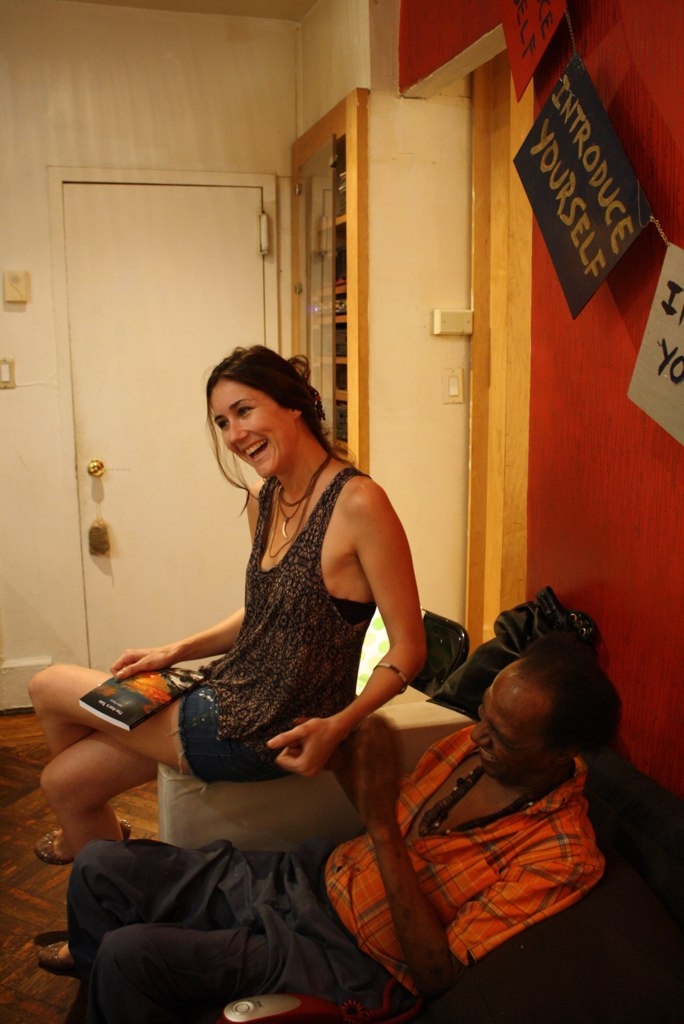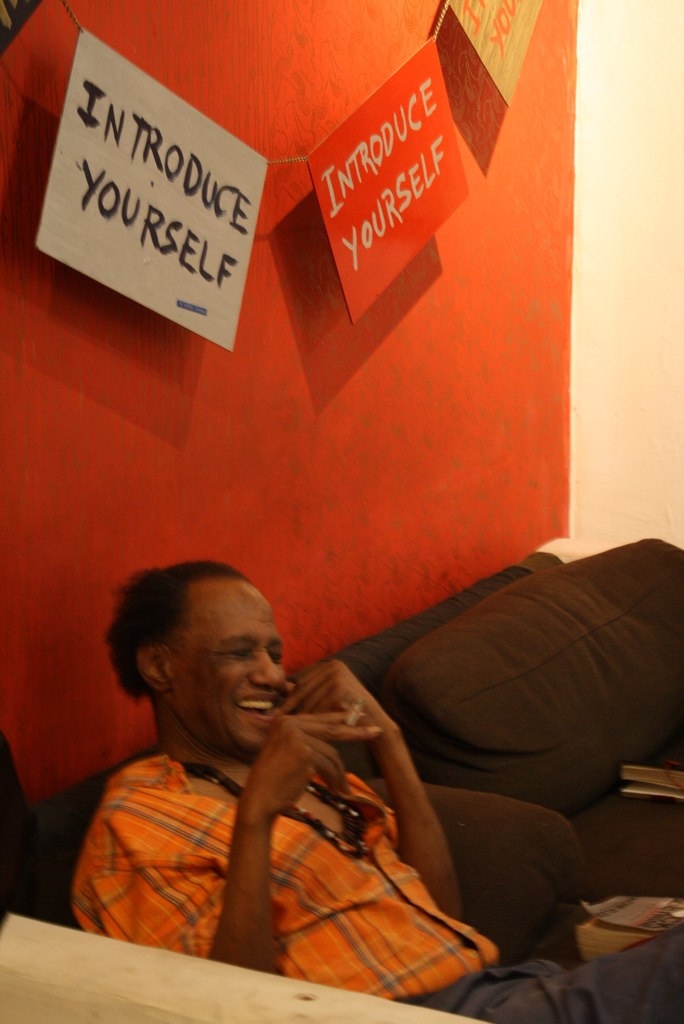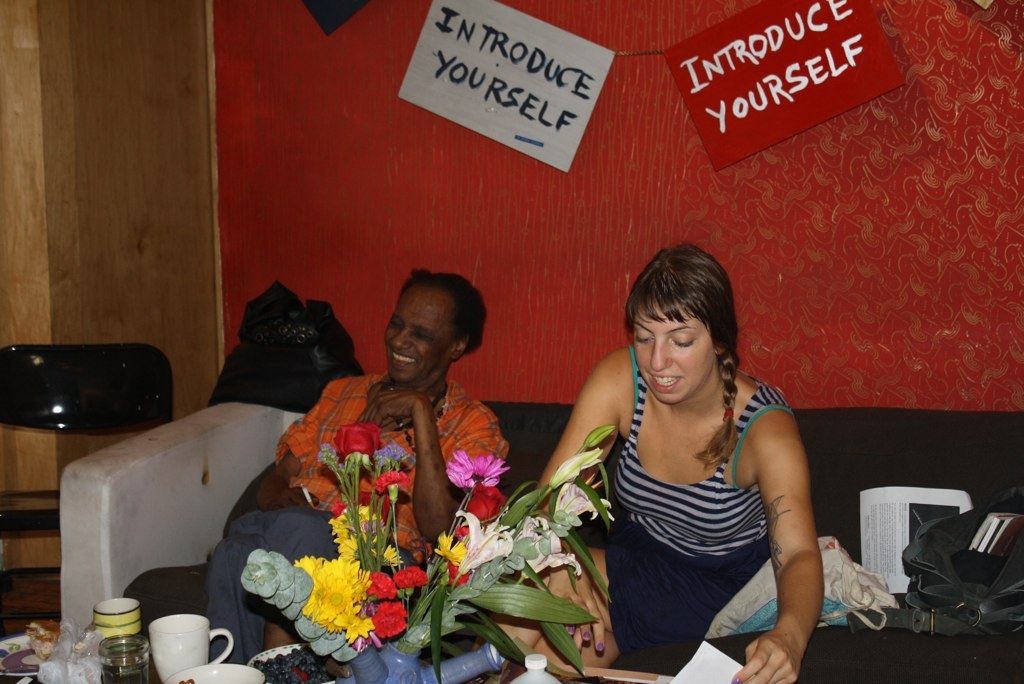A Gathering of the Tribes
By Maya Millett Steve Cannon, a fixture on the Lower East Side literary scene for years, reclines on his worn brown and white couch, reveling in the atmosphere around him. Young painters and gray-haired poets discuss art, politics and their work while Mr. Cannon interjects from time to time to offer an encouraging word or raise a point of opposition. A steady current of past and present interns, neighborhood friends and curious newcomers drift in and out of his comfortable second floor apartment, seemingly with no other agenda than to get caught up in the free-flowing energy of the space. With a lit Winston in one hand and his red and gray landline phone in the other, Steve Cannon mans the art institution that is A Gathering of the Tribes.
Mr. Cannon, who is now blind from glaucoma, started A Gathering of the Tribes in 1991 as a salon where young artists could exchange ideas and workshop their pieces. During the same year, Mr. Cannon produced the first issue of A Gathering of the Tribes magazine, which has since published twelve issues and encompasses a heady mix of poetry, fiction, reviews, essays and interviews by both unknown and famous artists from around the world. It’s a feat that Marvin Taylor, director of New York University’s Fales Library, says many other cultural institutions in the area aspired to achieve, but few accomplished with as much success.
“Tribes was one of those very important performance venues downtown,” says Mr. Taylor, who collected Tribes material for the library’s Downtown Collection, an archive of the post-1975 downtown New York arts and culture scene. “It was the most multicultural of them all—It’s still a vibrant place.”
Mr. Cannon’s apartment at 285 East Third Street has been a meeting ground for the East Village’s creative minds since he bought it in 1970. But when he arrived to New York eight years earlier in 1962, he was just a young black poet from New Orleans determined to conquer the artistic wilderness of the Lower East Side. He became friendly with abstract expressionist painters and the Beat poets, and shortly thereafter he was pulled into the burgeoning Black Arts Movement, headed by writer Amiri Baraka—then known as LeRoi Jones.
When the Movement relocated to Harlem, Mr. Cannon stayed behind. “I felt comfortable being in an integrated community, and I didn’t want to limit my vision and my ideas to one group,” he says. “I wanted to be around people that came from every perspective you and I could imagine.”
For Mr. Cannon, that kind of creative mélange could only be found in the East Village. He became involved in the Black Arts Movement’s literary magazine, Umbra, and worked to expand the publication’s ethnic scope by petitioning for local artists from his neighborhood to obtain a spot within its pages. “At that time you had a bunch of young, aspiring Puerto Ricans down here who wanted to be poets, and I was trying to get the Black Arts Movement to spread the wealth with the magazine.”
Sharing the wealth of his own experiences is something Mr. Cannon has been committed to for the past 40 years. In 1971 he started what would become an 18-year teaching career at Medgar Evers College, where he taught various art history and appreciation courses. He stepped down in 1989 after his deteriorating eyesight forced him to retire.
At 75, Mr. Cannon continues to advocate for young artists through the vehicle of A Gathering of the Tribes. A tranquil back garden on the lower level of the building hosts a plethora of poetry readings, music performances and plays. The room adjacent to the living area of his apartment was transformed into an art gallery where group shows are preferred over solo exhibitions so the organization can maximize the amount of artists shown at once.
Marie Hansen, 27, who has been working as Tribes’ artistic coordinator for the past year, says that while they continue to expand, like many nonprofit arts organizations, the monetary support needs to grow as well.
“We are needing funds. Places that have funded us in the past are not able to put us in their budget,” she explains. “It’s been a tough year for Tribes for sure.”
Tightened city purse strings forced Tribes to downgrade their annual Charlie Parker Festival this year, a month long celebration in August of the famous jazz saxophonist which culminates with a block party at the end of the month, Parker’s birthday. More worrying still is the launch of the thirteenth issue of Tribes magazine, set for release in the fall—if they can gather enough funds to see it to print.
But while money woes are a reality for A Gathering of the Tribes, Ms. Hansen remains hopeful about the organization’s future. “Tribes is legendary, we have to keep it going!” she exclaims.
“He is kind of like a chief for the underworld of emerging and struggling artists who really need just a voice,” Ms. Hansen continues. “You can have a show in New York City because Steve will let you.”
The lights inside Mr. Cannon’s apartment often shine brightly late into the night, serving as a helpful guidepost to those bohemian wanderers who may be searching for a place to grow.



